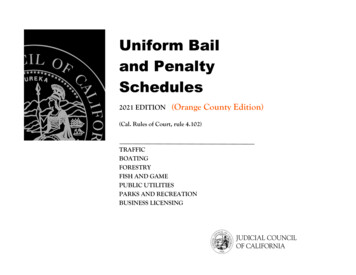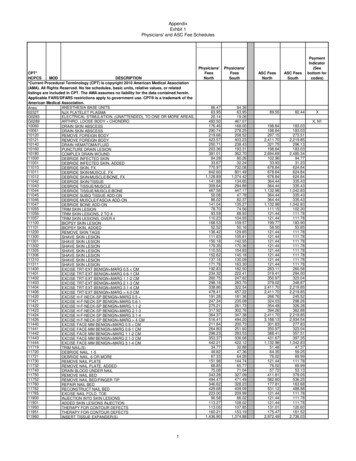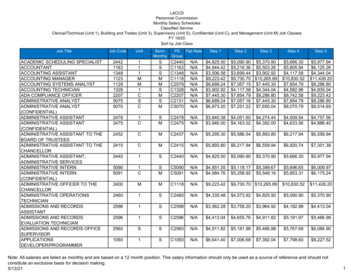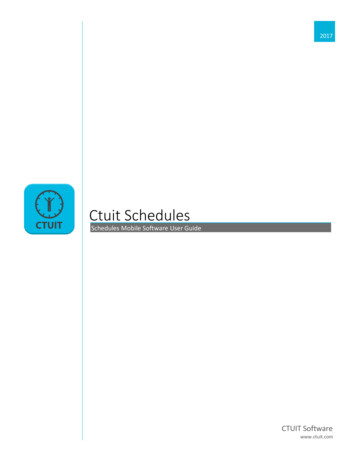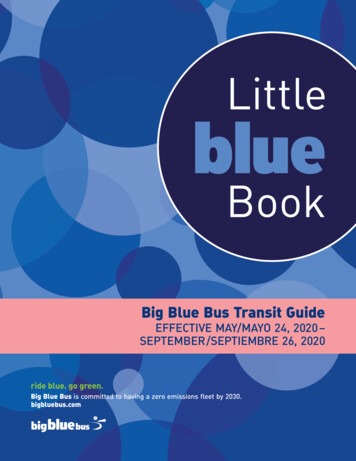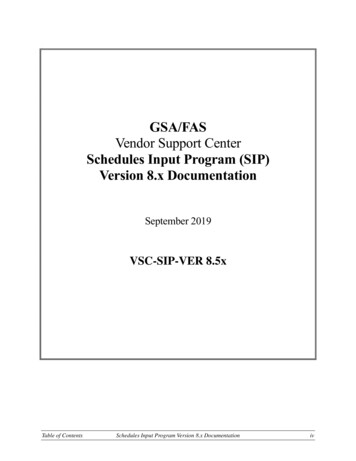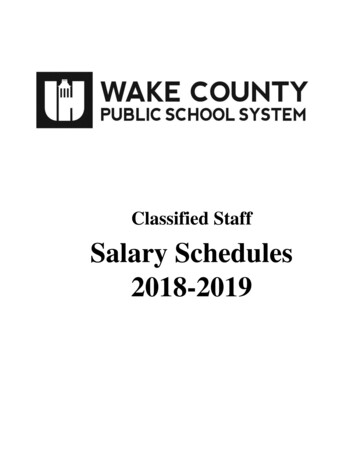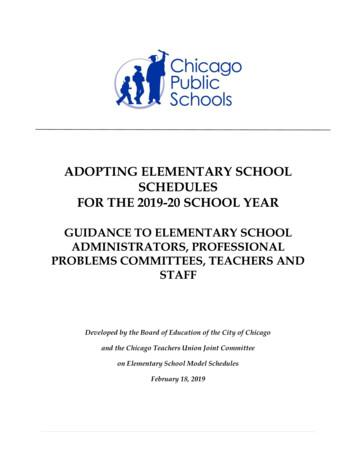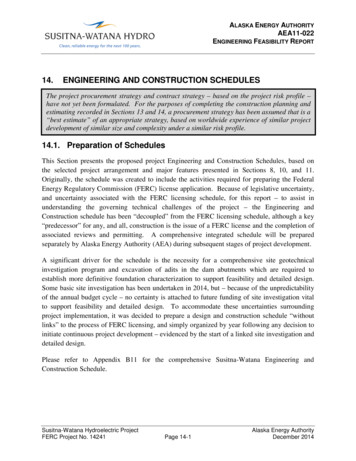
Transcription
ALASKA ENERGY AUTHORITYAEA11-022ENGINEERING FEASIBILITY REPORT14.ENGINEERING AND CONSTRUCTION SCHEDULESThe project procurement strategy and contract strategy – based on the project risk profile –have not yet been formulated. For the purposes of completing the construction planning andestimating recorded in Sections 13 and 14, a procurement strategy has been assumed that is a“best estimate” of an appropriate strategy, based on worldwide experience of similar projectdevelopment of similar size and complexity under a similar risk profile.14.1. Preparation of SchedulesThis Section presents the proposed project Engineering and Construction Schedules, based onthe selected project arrangement and major features presented in Sections 8, 10, and 11.Originally, the schedule was created to include the activities required for preparing the FederalEnergy Regulatory Commission (FERC) license application. Because of legislative uncertainty,and uncertainty associated with the FERC licensing schedule, for this report – to assist inunderstanding the governing technical challenges of the project – the Engineering andConstruction schedule has been “decoupled” from the FERC licensing schedule, although a key“predecessor” for any, and all, construction is the issue of a FERC license and the completion ofassociated reviews and permitting. A comprehensive integrated schedule will be preparedseparately by Alaska Energy Authority (AEA) during subsequent stages of project development.A significant driver for the schedule is the necessity for a comprehensive site geotechnicalinvestigation program and excavation of adits in the dam abutments which are required toestablish more definitive foundation characterization to support feasibility and detailed design.Some basic site investigation has been undertaken in 2014, but – because of the unpredictabilityof the annual budget cycle – no certainty is attached to future funding of site investigation vitalto support feasibility and detailed design. To accommodate these uncertainties surroundingproject implementation, it was decided to prepare a design and construction schedule “withoutlinks” to the process of FERC licensing, and simply organized by year following any decision toinitiate continuous project development – evidenced by the start of a linked site investigation anddetailed design.Please refer to Appendix B11 for the comprehensive Susitna-Watana Engineering andConstruction Schedule.Susitna-Watana Hydroelectric ProjectFERC Project No. 14241Page 14-1Alaska Energy AuthorityDecember 2014
ALASKA ENERGY AUTHORITYAEA11-022ENGINEERING FEASIBILITY REPORT14.1.1.CalendarAlthough the pre-construction activities will be performed on the basis of an “office” (i.e. 5-daywork week) calendar, there are also two different calendars applying to construction work on thesite (described below), together with some key constraints.The weather at the site is a major factor, particularly the arduous winter weather which will havea significant effect on the various contractors construction scheduling.Certain activities can be continued during the winter economically and productively, asdemonstrated during the construction of the recent Karahnjukar hydro project in Iceland. Theseactivities include: underground works (tunneling); conventional concreting, which can be performed under temporary insulated weatherprotection; quarry development, and rock excavation can also be continued under adverse conditions,but it is expected that the output will be compromised somewhat during inclementweather; overburden removal and the associated foundation rock excavation; curtain grouting from within the galleries in the dam; road construction, which may be able be performed in winter, depending on thegeotechnical conditions in the corridor and moisture and density controls; and, all activities within the powerhouse, after weather proofing of the powerhouse structure.There are also activities that are most appropriately and efficiently conducted during the wintermonths, when the river level is low, such as: cofferdam construction; river diversion; and, permanent road bridge construction.In contrast, there are significant activities that, at this stage of planning, must be assumed to becarried out only during summer months, which in a typical year is effectively only a five to sixmonth window. Principal among these are the final shaping of the dam foundations, theconsolidation grouting of the dam foundations, and the placement of roller compacted concrete(RCC). The current project schedule places RCC on the left and right abutments until such timeSusitna-Watana Hydroelectric ProjectFERC Project No. 14241Page 14-2Alaska Energy AuthorityDecember 2014
ALASKA ENERGY AUTHORITYAEA11-022ENGINEERING FEASIBILITY REPORTas the cofferdams are constructed, the river diverted and the center portion of the dam isavailable to place RCC.The challenge for a contractor will be to organize all RCC placement activities in such a way thatthe season “shoulders” are extended as much as possible, particularly the period of Septemberand October, to maintain production before having to shut down for the winter.Because of the two parallel “controls” on work, two calendars have been used for constructionactivities in the Primavera P6 scheduling software, one based on normal working weeks(including public holidays), and a second including specific winter shutdowns.14.1.2.ConstraintsIn addition to the nuances of summer and winter construction, one key environmental constrainthas been included at this time – that is, the effect of migratory birds – which means that noclearing can be performed during bird nesting season. To comply with this regulation, initialclearing will take place in the winter season.Although activities leading up to the issue of a FERC license have not been included in theschedule, it has been assumed that no construction work of any kind – including the access road– can be commenced before the award of a FERC license and the associated approvals by FERC,and the issuance of permits, most particularly the Corps of Engineers Section 404 permit.This constraint on construction is particularly important because access to the site is currentlyconsidered to be within the licensed works and the access road (which is some 50-60 miles long)is the sole method of mobilization and hence on the critical path of the whole projectdevelopment.As discussed in Section 13, construction is assumed to be implemented in seven constructionpackages and one supply contract, with (essentially) all implementation being performed under atraditional sequence of an engineering design contract, followed by a construction contract. Ithas also been assumed that at least four contracts will be let for the provision of services such asrailroad service, and aircraft operation.14.1.3.Individual Contract SchedulesIn deriving the comprehensive Engineering and Construction Schedule, six “break out”schedules were created for the assumed construction contracts: Clearing Permanent Access RoadSusitna-Watana Hydroelectric ProjectFERC Project No. 14241Page 14-3Alaska Energy AuthorityDecember 2014
ALASKA ENERGY AUTHORITYAEA11-022ENGINEERING FEASIBILITY REPORT Rail Siding Camp and Airstrip Civil Works Camp and Airstrip Buildings Main Civil ContractsThey are shown below in Figure 14.1-1 through Figure 14.1-6.Susitna-Watana Hydroelectric ProjectFERC Project No. 14241Page 14-4Alaska Energy AuthorityDecember 2014
ALASKA ENERGY AUTHORITYAEA11-022ENGINEERING FEASIBILITY REPORTFigure 14.1-1. Clearing Construction ScheduleSusitna-Watana Hydroelectric ProjectFERC Project No. 14241Page 14-5Alaska Energy AuthorityDecember 2014
ALASKA ENERGY AUTHORITYAEA11-022ENGINEERING FEASIBILITY REPORTFigure 14.1-2. Permanent Access Road Construction ScheduleSusitna-Watana Hydroelectric ProjectFERC Project No. 14241Page 14-6Alaska Energy AuthorityDecember 2014
ALASKA ENERGY AUTHORITYAEA11-022ENGINEERING FEASIBILITY REPORTFigure 14.1-3. Rail Siding Construction ScheduleSusitna-Watana Hydroelectric ProjectFERC Project No. 14241Page 14-7Alaska Energy AuthorityDecember 2014
ALASKA ENERGY AUTHORITYAEA11-022ENGINEERING FEASIBILITY REPORT14.1.3.1. Camp and Airstrip Civil Works ScheduleFigure 14.1-4. Camp and Airstrip Civil Works Construction ScheduleSusitna-Watana Hydroelectric ProjectFERC Project No. 14241Page 14-8Alaska Energy AuthorityDecember 2014
ALASKA ENERGY AUTHORITYAEA11-022ENGINEERING FEASIBILITY REPORT14.1.3.2. Camp and Airstrip Buildings ScheduleFigure 14.1-5. Camp and Airstrip Building Construction ScheduleSusitna-Watana Hydroelectric ProjectFERC Project No. 14241Page 14-9Alaska Energy AuthorityDecember 2014
ALASKA ENERGY AUTHORITYAEA11-022ENGINEERING FEASIBILITY REPORTSusitna-Watana Hydroelectric ProjectFERC Project No. 14241Page 14-10Alaska Energy AuthorityDecember 2014
ALASKA ENERGY AUTHORITYAEA11-022ENGINEERING FEASIBILITY REPORTSusitna-Watana Hydroelectric ProjectFERC Project No. 14241Page 14-11Alaska Energy AuthorityDecember 2014
ALASKA ENERGY AUTHORITYAEA11-022ENGINEERING FEASIBILITY REPORTFigure 14.1-6. Main Civil Construction ScheduleSusitna-Watana Hydroelectric ProjectFERC Project No. 14241Page 14-12Alaska Energy AuthorityDecember 2014
ALASKA ENERGY AUTHORITYAEA11-022ENGINEERING FEASIBILITY REPORT14.2. Construction Schedule Derivation14.2.1.GeneralPreliminary project schedules have been developed first for the complete project engineering andconstruction works – beginning with the site investigation and adit construction – and included inAppendix B11; and, second for the various construction packages (except transmission) shownabove using the shortest reasonable time based on knowledgeable, experienced, and qualifiedU.S.-based contractors using high efficiency equipment and working methods.The schedules can be regarded as aggressive, particularly in the earliest stages of construction.The construction of access to the site is critical to the current schedule. Access to the dam hasbeen scheduled by pioneering to the site as soon as possible – along the line of the access road –with the conversion to permanent access road following. If this access cannot be completed, theoverall schedule will be delayed.The construction sequence was scheduled initially based on the expected date of FERC licenseissuance. The schedule for engineering required to facilitate construction was developedsubsequently. The feasibility level construction schedule was developed based on the currentconcept design, and based on a logical work flow and interrelation among activities.The following assumptions have been used to develop the construction schedule: The time required for execution of each activity was based on expected production rates. Activities start and finish dates reflect the “early start and finish” dates as that is thestandard for Primavera until an activity is given an “actual start and finish” date. Seven-day work week. Surface work is based on two 10-hour shifts per day. Underground construction based on 24-hour per day production. Regional public holidays will be observed. Scheduling of electrical/mechanical equipment supply and installation is based on supplyand installation times observed for similar types of equipment installed at similar damand power house projects. The supply chain, via barges from the Lower 48, the Alaska Railroad, and the projectaccess road, is not a constraint, and logistics will always be organized to support therequired construction activities.Susitna-Watana Hydroelectric ProjectFERC Project No. 14241Page 14-13Alaska Energy AuthorityDecember 2014
ALASKA ENERGY AUTHORITYAEA11-022ENGINEERING FEASIBILITY REPORTTraditional analysis was performed before calculating the durations based on planned andexpected resources. The analysis compared the derivation of the logic associated with each task,and the establishment of links and precedence.The tasks and links have been entered into Primavera P6 scheduling software and a Gantt chartderived, together with a critical path.14.2.2.Potential Early WorksThe road contemplated for access to the site has no use other than for construction (andoperation) of the works. As noted, because of this sole use, the project to be licensed by FERCincludes the access route, and (if Gold Creek or Chulitna road route is chosen) the associatedrailroad offloading yard. As noted, the inclusion of the access within the project subjects it toprohibition of construction before the FERC license is granted, and all associated permits anddesign reviews are complete. In other circumstances, the access would normally be constructedin advance of the main works so that the main project works could be implemented as soon asthe license (and associated permits) was granted.Although the linkage between the project works and the licensing has been removed for thereasons stated earlier, it is recognized that the schedule cannot be shortened if no works on siteare commenced until the access road is complete. It is thus beneficial for construction works atthe main site to begin as soon as possible, and the project team has considered the logic for, earlyaccess by “Rolligon” It must be noted, however, that although this storing of materials and planthas been included in the schedule, as described in the following paragraph, the implementationof such prepositioning might still be classed as “construction” by regulatory authorities andprudent scheduling would require that such activity not be commenced until the license is issuedand the associated permits obtained.It has been assumed that for the preparation of the camp civil works - and the preliminarygrading of the airstrip - Rolligons (or snow CAT train) access will be used to transport plant andmaterials to the site before the road construction has reached the dam site. “Rolligon” is ageneric name for a very low ground pressure vehicle used to transport equipment and suppliesover snow c
This Section presents the proposed project Engineering and Construction Schedules, based on the selected project arrangement nd major features presented an Sections 8, 10a,nd 11. i Originally, the schedule was created to include the activities required for preparing the Federal Energy Regulatory Commission(FERC ) license application. Because of legislative uncertainty,
